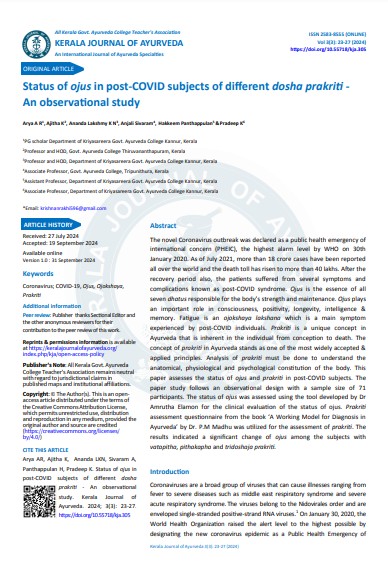Status of ojus in post-COVID subjects of different dosha prakriti - An observational study
DOI:
https://doi.org/10.55718/kja.305Keywords:
Coronavirus; COVID-19, Ojus, Ojokshaya, PrakritAbstract
The novel Coronavirus outbreak was declared as a public health emergency of international concern (PHEIC), the highest alarm level by WHO on 30th January 2020. As of July 2021, more than 18 crore cases have been reported all over the world and the death toll has risen to more than 40 lakhs. After the recovery period also, the patients suffered from several symptoms and complications known as post-COVID syndrome. Ojus is the essence of all seven dhatus responsible for the body’s strength and maintenance. Ojus plays an important role in consciousness, positivity, longevity, intelligence & memory. Fatigue is an ojokshaya lakshana which is a main symptom experienced by post-COVID individuals. Prakriti is a unique concept in Ayurveda that is inherent in the individual from conception to death. The concept of prakriti in Ayurveda stands as one of the most widely accepted & applied principles. Analysis of prakriti must be done to understand the anatomical, physiological, and psychological constitution of the body. This paper assesses the status of ojus and prakriti in post-COVID subjects. The paper study follows an observational design with a sample size of 71 participants. The status of ojus was assessed using the tool developed by Dr Amrutha Elamon for the clinical evaluation of the status of ojus. Prakriti assessment questionnaire from the book ‘A Working Model for Diagnosis in Ayurveda’ by Dr. P.M Madhu was utilized for the assessment of prakriti. The results indicated a significant change of ojus among the subjects with vatapitha, pithakapha and tridoshaja prakriti.
References
Weiss SR, Martin SN. (2005, December). Coronavirus pathogenesis and the emerging pathogen severe acute respiratory syndrome coronavirus. National Library of Medicine. https://pubmed.ncbi.nlm.nih.gov/16339739/
Coronavirus disease (COVID-19) pandemic. (n.d.). World Health Organization, Europe. https://www.euro.who.int/en/healthtopics/healthemergencies/coronavirus-COVID-19/novelcoronavirus-2019-ncov
Alimohamadi Y, Sepandi M, Taghdir M, Hosamirudsari H. Determine the most common clinical symptoms in COVID-19 patients: a systematic review and meta-analysis. Journal of preventive medicine and hygiene. 2020 Sep; 61(3):E304. https:// doi.org/10.18502/ijph.v49i7.3574
Raveendran AV, Jayadevan R, Sashidharan S. Long COVID: an overview. Diabetes & Metabolic Syndrome: Clinical Research & Reviews. 2021 May 1; 15(3):869-75. https://doi.org/10.1016/ j.dsx.2021.04.007
Kamal M, Abo Omirah M, Hussein A, Saeed H. Assessment and characterisation of post-COVID-19 manifestations. International journal of clinical practice. 2021 Mar; 75(3). https:// doi.org/10.1111/ijcp.13746
Jadavji Trikamji. Charaka Samhitha of Agnivesa with ayurveda dipika commentary of chakrapanidatta. Reprint edition. Vimanasthanam. Ch.3/6. Chowkambha Sanskrit series, Varanasi; 2012.240 p.
Gaidhani KV, Chalakh S.P. COVID-19 is a janapadodwans vyadhi in Ayurveda - a review. International Journal of Research in Pharmaceutical Sciences. 2020:1363-6. https://doi.org/10.26452/ ijrps.v11iSPL1.3642
Yadavji Trikamji. Susurtha samhita of Susruta with Nibandasangraha commentary of Dalhana and Nyayachandrika Panchika commentary of Gayadasa, Reprint edition. Nidanasthanam. Chapter 5 choukambha Sanskrit sansthan, Varanasi; 2012. 289 p.
Pandkar PD, Sachdeva V. Pathophysiology of COVID-19 and host centric approaches in Ayurveda. Journal of Ayurveda and Integrative Medicine. 2022 Jan 1; 13(1):100380. https:// doi.org/10.1016/j.jaim.2020.11.010
KR Srikantha Murthy, Susrutasamhita Reprint ed. Vol. 1 Sutra sthanam. Ch.15/19. Chaukambha Orientalia, 2012. 104 p.
Aparna M, Dharini AV, Murthy KS, Sudhakar PS, Srinivas K. (2018, August). Concept of ojus - Its Significance and Relevance in Life Style Disorder. Journal of Medical Science and Clinical Research, 06(08), 787.
T Sreekumar. Ashtangahrudayam. 7th ed. Vol. 1 Sutrasthanam. Ch. Ayushkamiyam 1/10. Harisree hospital, Mannuthy, trissure; 2015. 33 p.
Rajan S, Munjal Y, Shamkuwar M, Nimabalkar K, Sharma A, Jindal N, et al. Prakriti Analysis of COVID-19 Patients: An Observational Study. PubMed. 2021 Jun 1; 27(S1):1-17.
KR Sreekantha Murthy. Illustrated Susruta Samhita, text with English translation, notes, appendices and index. Reprint edition. Volume 1, sutrasthana. Ch. 21/9. Chaukhamba Orientalia, Varanasi; 2022. 154 p.
Ram Karan Sharmaand Vaidya Bhagwan Dash. Agnivesa’s Charaka samhita. Reprint edition. Volume I, Sutrasthana. Chapter 12/11. Chowkhamba Sanskrit series office, Varanasi; 2018. 240 p.
Agnivesha, Charaka Samhita revised by Charaka and Drdhabala with Ayurveda dipika commentary of chakarpanidatta, edited by Jadavji tikamji. Reprint ed. Sutra sthanam. Ch.12/11 choukhamba krishnadas academy, Varanasi; 2012. 80 p.
KR Srikantha Murthy. Vagbhata’s Astanga Hrdayam (text with English translation, notes, appendix and index). 10th edition. Vol. 1, Sutra sthana, Ch.12/10-12. Chowkhamba Orientalia, Varanasi; 2014. 168 p.
R. Vidyanath, Prof. K. Nishteswar. Illustrated Sarngadara Samhita of Acharya Sarngadara. 1st ed. Purva khandam. Ch. 5/25. Chaukhamba Surbharati Prakashan, Varanasi; 2021. 30.





